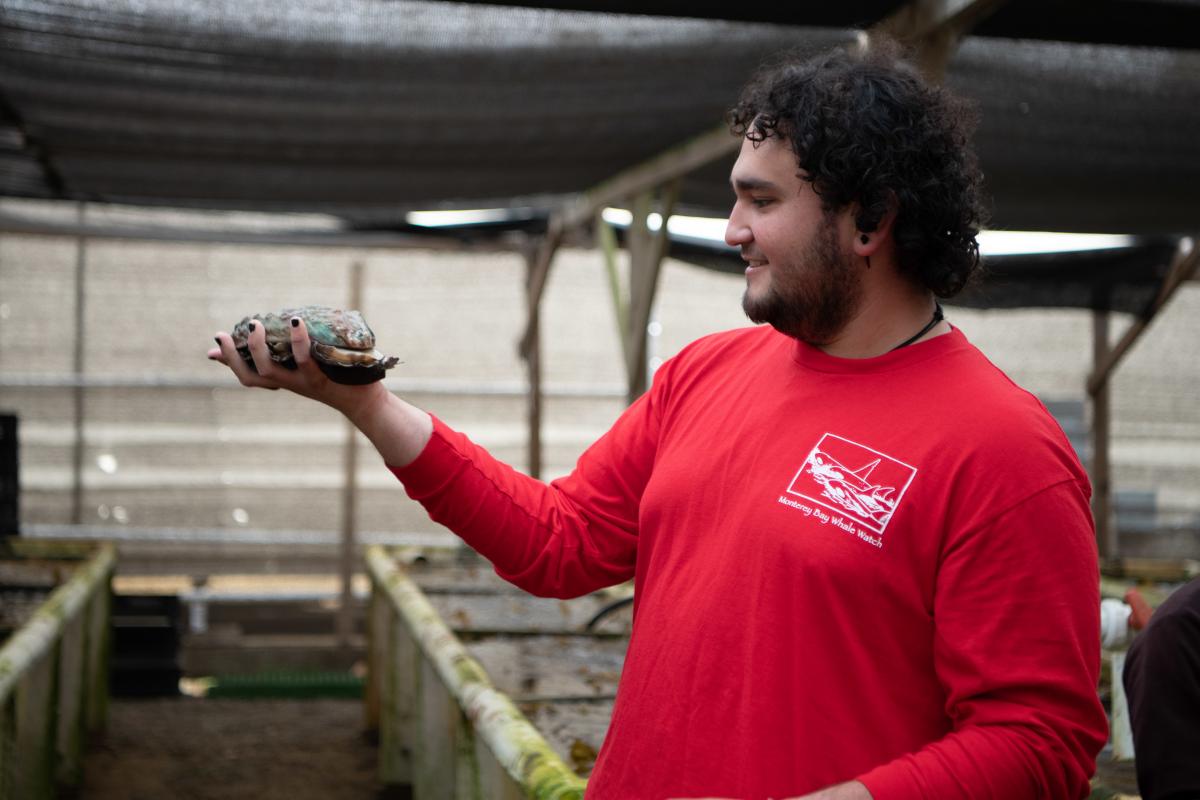Bringing Aquaculture Mainstream

eeBLUE: Harvest Stories
This post is written by Devin Spencer, Hatchery and Production Manager at TCAF.
It was a sunny afternoon in late September when a quiet buzz of excitement filled the air as Santa Barbara Sea Center aquarium staff arrived in the parking lot at The Cultured Abalone Farm (TCAF). As the hatchery and production manager, I have been in “the business” for over four years, but as the day’s tour guide, I was nervous. “These are aquarists!” I told myself, “They know the ocean, and particularly the California coast.” However, nerves quickly turned into excitement as the questions started coming. My visitors had a basic knowledge that allowed me to go deep into abalone biology, water chemistry, and husbandry, while also feeding on the excitement of visitors who have never seen large-scale aquaculture in real life.
Situated along California's Gaviota coastline, on Dos Pueblos Canyon Ranch, the land that The Cultured Abalone Farm inhabits has a rich history of abalone harvest and cultivation. In the 1500s, abalone satiated the hunger of the two Chumash tribes who inhabited the bluffs above a tree-lined river valley below. The shells provided currency for trade, and the beautiful iridescent yet strong shell material was used to craft jewelry and fishing hooks. During the discovery of the Gaviota coast by Spanish explorer Juan Cabrillo in 1542, the two tribes were named dos pueblos (or two towns in English) and the name stuck. Fast forward 500 years and the valley once used by the two pueblos as fishing grounds, has become home to growing the abalone that once lived in great abundance just offshore.

Starting at the highest point on the farm, the two 8,000 gallon head tanks that allow raw seawater to be distributed throughout the farm’s some 400 tanks via gravity, the Sea Center staff followed the life of a hand-cultured red abalone, from egg and sperm in the hatchery to saleable animal ready for market in the packhouse. Along the way, they picked up tidbits about abalone biology, how different macroalgae consumed by the abalone produce different coloration on their shells, and how one manages one million animals while maintaining an environmentally conscious system. Each has an insight into commercial abalone aquaculture that they now can take back and share with their visitors.
After visiting TCAF, the Sea Center staff shared their thoughts. Olivia, a Sea Center Interpreter, found it fascinating to learn how TCAF not only grows red abalone for food production but, just like the Sea Center, is part of the White Abalone Captive Breeding Program, which is focused on raising the endangered white abalone in captivity for restoration purposes. She was impressed that TCAF shares so much knowledge about best abalone husbandry practices with other facilities involved in raising white abalone. Olivia was encouraged to know that businesses are using their expertise to contribute to conservation projects and excited to use her expanded understanding of aquaculture's role in abalone restoration while designing the new White Abalone Exhibit for the Sea Center. The Sea Center’s Director of Education, Jenna loved “observing (her) own colleagues engaging with their surroundings in the same exploratory ways visitors discover and learn at (the) Sea Center and Museum.
Through the tour, I learned it is important to share the world of aquaculture with anyone who is interested. While the Sea Center staff work in the field of marine science and science education, many were unaware of the scale at which aquaculture facilities can operate and do so in a sustainable manner. Yet, the Sea Center practices abalone aquaculture on a small scale every day!

As part of the White Abalone Captive Breeding Program, they too are raising abalone in an aquaculture setting for restoration purposes and even more importantly they are the guide to understanding the importance of aquaculture for the general public. By visiting TCAF, the Sea Center staff were able to learn in the same way that they help students and the general public learn every day!
With the end of the first of many educational abalone tours, TCAF was excited to expand our reach from SCSB staff to Santa Barbara High School students who had been learning about abalone through an interdisciplinary unit of instruction created by our project partners. From exploring the history of the abalone fishery in California to understanding their biology and husbandry, students learned about sustainable aquacutlure using abalone as a case study. TCAF was excited to welcome the students to bring what they had learned over six months in the classroom to life, and the students were rearing to get their hands wet in abalone tanks! However, in these COVID-impacted times, we have learned that we must take advantage of the time we are given and be flexible in times of change. While TCAF did not get to host Santa Barbara High School students in January, as planned, we are excited to host two in-person tours in the spring to bring their learning experience full circle.
Through the NOAA-NAAEE Collaborative Aquaculture Literacy mini-grants program, NAAEE supports partnerships sharing the mutual aquaculture literacy goals of the National Oceanic and Atmospheric Administration’s (NOAA) Office of Education, National Marine Fisheries Service (NMFS), and National Sea Grant Office. These mini-grants provide informal learning institutions (e.g., aquariums), aquaculture industry (e.g., shellfish, finfish, seaweed farmers), and NOAA partners with support for the co-development of innovative educational experiences that explore aquaculture topics and support the engagement and advancement of public aquaculture literacy.


